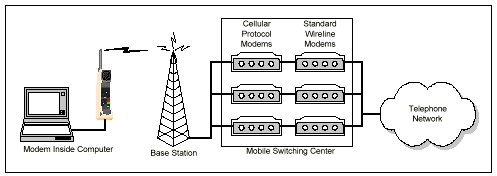|
Data Over Analog Cellular |
More and more people are using the analog cellular network for data communications. Transmitting data over an analog cellular network, historically, has been highly problematic, but new modem protocols are making this method of data transfer a viable solution for the first time. And new generations of modems and cellular telephones allows users to easily connect their PC Card modem to their cellular telephone.
Transmitting data over analog cellular involves a circuit-switched connection versus a packet-switched connection (such as CDPD uses).

Data over analog cellular is best suited for applications where connection or call setup time is not an issue and the amount of data to be exchanged in a single session is large.
Extended file transfers and batch operations are examples of good applications for data over analog cellular. Today, analog cellular offers extremely broad coverage across the U.S.—in fact, better coverage than any other wireless network in the
A mobile computer uses a modem and data is sent and received in a manner similar to that of normal wireline modems. However, when you use circuit-switched cellular with this approach, slight differences must be addressed.
First, cellular telephones do not provide a dial tone. Secondly, the radio frequency (RF) connection is largely incompatible with standard modem protocols. Finally, when a mobile device switches from one base station to another (moves from cell to cell), thisit causes a momentary interruption in the connection, which causes many modems to hang up. Using standard Hayes AT-compatible modems is simply not practical over analog cellular connections.
To address these problems, modem companies have developed modems specifically for cellular communications. Foremost among these are modems based on AT&T’s Enhanced Throughput Cellular, or ETC, technology. Two other companies have developed modem protocols for cellular connections: Microcom with MNP 10 and MNP10EC, and Motorola with EC 2 . New cellular-ready modems incorporate these protocols and also address the problem of cellular phones not providing a dial tone. Consequently, cellular-ready modems can be connected directly to many new cellular phones for reliable communications.
Using cellular-ready modems, 7200 bps to 9600 bps connections are generally possible. Speeds up to 14.4 kbps are sometimes possible, although generally not seen, and represent the current upper limit for cellular connections though higher speed technologies are in development.
Another important and recent development has been the installation of modem pools at cellular-switching centers. These modem pools act as a gateway that translates between cellular modem protocols and traditional modem protocols. For cellular modem protocols to be effective, they must be implemented by each modem at either end of a connection.
These modem pools provide reliable connections to modems resident at the host or server site, even though they traditionally do not support cellular protocols. For example, a user wishing to connect reliably to America Online over a cellular connection can do so through a modem pool, even though America Online’s modems do not support protocols such as ETC and MNP 10.

Wireless Modems Wireless modems have two components. The first component is the modem itself, typically packaged in PC CardPCMCIA format. As discussed previously, optimal performance comes from using protocols optimized for the cellular environment.
The other component is the cellular telephone. With the right cable, users can plug their PC Card modem directly to their cellular telephone.In the future, users will be able to purchase PCMCIA devices that combine the modem and cellular phone.
With an integrated device, the user will not need to connect the modem to a cellular telephone as is currently the case. The integrated device will be all the user needs for data communications over cellular networks.
For vertical markets, OEM modules are availablenon-PCMCIA devices that combine modem and cellular telephone capabilities exist today.
| Send comments to webmaster Copyright © 1997 Derek Mc Donnell. All Rights Reserved. Last updated 07-Apr-1998. |
 |